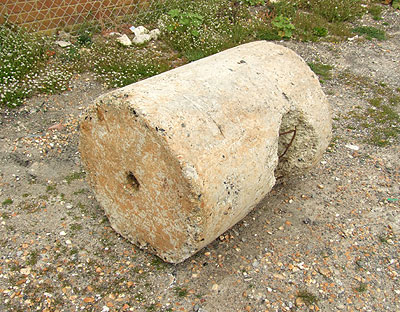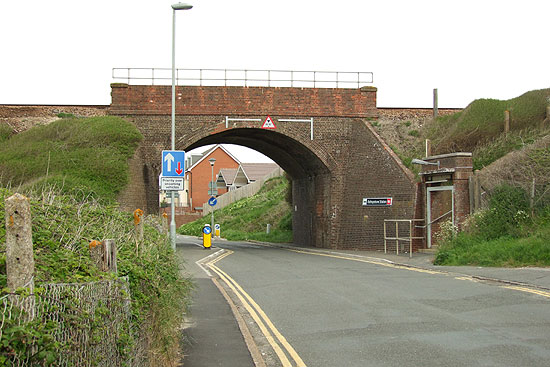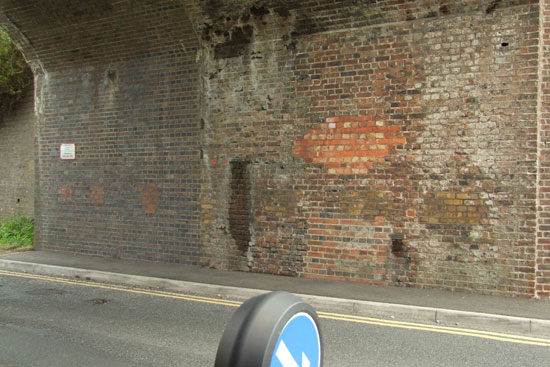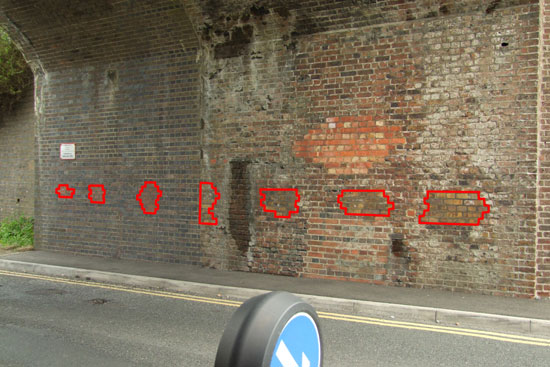Demolition chambers
Posted: 9 May 2008 22:29
I find bank holiday weekends a double-edged sword; while I love the extra day off, it's annoying not being able to do normal things.
One such activity that was denied me was a chance to go back to The National Archives last Saturday (3rd May) to continue my research into Canadian war diaries.
Frustrated by this, I decided to do a quick dive into some of the documents I looked at on my previous visit and do a 'crash' visit to a site without much in the way of research beforehand.
Normally I would pull together as many references to a site in order to gain maximum use of time, but as I was wanting to get out and do something at the drop of a hat, I decided to just crack on.
The area I chose was Bishopstone, near the twin pillbox on the station roof.

Arriving in the car park at Bishopstone, my first find of the day was this geometrically- challenged cylinder, which was probably from the roadblock situated on the sharp bend a short distance up the road; a couple of well-documented cylinders are in the grounds of the local sailing club.
My target was actually a little further up the road from the bend, the bridge immediately west of Bishopstone Station that carries the railway line over the road itself; the photo below is facing north.

A British infantry brigade scheme dated 28th June 1941 states that this bridge was "being prepared for demolition." The date is significant here; just four days later the Canadians would be relieving the British units in East Sussex.
A chance discovery of a numbered list of jobs pertaining to defence works in the war diary of a Royal Engineers (R.E.) Field Company gives job no.41A as the preparation of this bridge for demolition. As a fantastic piece of continuity, the first Royal Canadian Engineers (R.C.E.) diary I looked at contained references to the same job numbers!
Some jobs missing from the R.C.E. list indicates that the R.E. must have completed some of the jobs in hand before the Canadians took over and the latter kindly provide more detail about some jobs that the R.E. only make obscure reference to in their original list. If this were not enough, the Canucks have graced me not only with weekly progress reports, but also detailed daily diary entries that indicate the number of pimples poured at a particular site, the number and type of explosive charges used on another job, or just the sheer hard work of building defence works.
I found the 28th June demolition reference some time ago but had not visited the bridge since, even though I had a mental note to check for evidence of demolition chambers or other activity.
The photo below shows the eastern wall of the bridge; it would seem that the bridge was doubled in width at some point, judging by the different brickwork either side of the centre line.

Had I visited before my Canadian research, my focus would have been centred on the oval-shaped patch of brickwork, which I would have identified as a demolition chamber. A similar feature is present on the opposite wall. These may be evidence of the R.E. unit perhaps having started the job before the Canadians took over. The R.C.E. diary states:
Project 41A: Demolition chambers in R.R. (rail road) Bridge. This job consists of preparing seven chambers in the north wall of the bridge. The chambers are not to be loaded, and the fronts of the openings are to be bricked up. The chambers are 3ft. in from the face and are 12" x 6" x 6" in size. A compressor is being used.
The reference to the north wall is confusing; however, a casual second look revealed three small patches of red brickwork amongst the blue-grey masonry on the left side in the photo. Closer inspection using the eye of faith revealed another four patches at a similar height in yellow brick on the half of the bridge built of red brick, presumably to make the chambers more visible. The photo below highlights them.

But for documentary research, I would never have identified these seven chambers; the brickwork is such a mess in places, with various repair work having been done.
The work took four days to complete; perhaps the large patches of red brick were a failed R.E. attempt to do the job, or perhaps the Canadians were redoing it. The diary mentions one or two cases of the R.C.E. undoing R.E. jobs such as shoring up a building or sandbagging a gun emplacement and doing it to their specifications.
Either way, I was highly satisified with my half hour's fieldwork!
- Pete

Email:
Blog Latest

Bishopstone reveals its pillbox secrets
18 October 2021

Pillbox or Observation Post?
10 June 2020

Uncovering the hidden secrets of a pillbox
8 June 2019

Review of 2018
31 December 2018

Wartime Christmas in East Sussex (2)
24 December 2018
Jargon-buster
Cylinders
Reinforced concrete cylindrical obstacles with a shaft down the centre in which could be inserted a crowbar for manhandling, or a picket for barbed wire. Cylinders were 90cm high and 60cm wide and deployed in groups of three as a more effective alternative for buoys.
Demolition
Term applied to a structure scheduled for demolition or already demolished. Walls and small buildings might be taken down to clear fields of fire or impede enemy passage by destroying a bridge. Some demolitions were not intended to be carried out until after invasion had begun, for example, certain bridges or road craters (pipe mines).
Pillbox
Generic term for a hardened field defensive structure usually constructed from concrete and/or masonry. Pillboxes were built in numerous types and variants depending on location and role.

Pimples
Small anti-tank block in the form of a truncated pyramid. Pimples were used to extend anti-tank obstacles and roadblocks and were intended for use on soft ground.
War diary
A record of events kept by all units from the point of mobilisation. A diary's contents vary enormously from unit to unit; some give detailed entries by the hour on a daily basis while others merely summarise events on a weekly/monthly basis.
This site is copyright © Peter Hibbs 2006 - 2024. All rights reserved.
Hibbs, Peter Demolition chambers (2024) Available at: http://pillbox.org.uk/blog/216550/ Accessed: 27 July 2024
The information on this website is intended solely to describe the ongoing research activity of The Defence of East Sussex Project; it is not comprehensive or properly presented. It is therefore NOT suitable as a basis for producing derivative works or surveys!